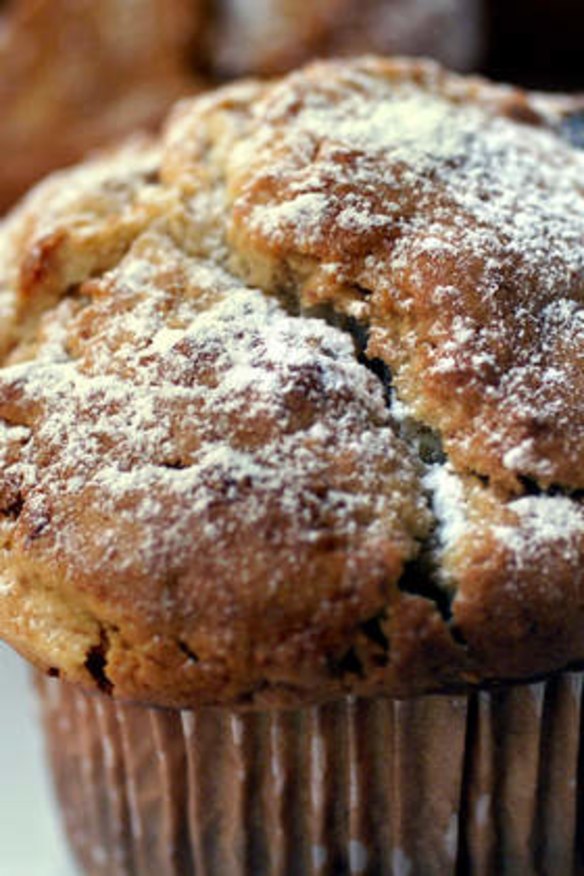A muffin mystery

Can you suggest how I can make muffins with the top slightly crusty but the inside still soft and moist? S. Lih
Crusty muffin top sounds like a skin disease you might contract in a shopping mall. Muffins are meant to be moist. A lot of the sensation of moistness comes from the amount of sugar in the recipe - most have equal quantity of sugar to flour. Sugar forms bonds with water in the eggs, butter and any water-based liquids. These bonds hold a lot of the water in muffins during baking. You can get a drier-topped muffin by substituting butter, which is about 15 per cent water, for neutral oil such as grapeseed. What you might find then is sugar crystals forming on top of the muffin which will help create crunch. Phillippa Grogan from Phillippa's bakery suggests you could add some extra sugar and cook the muffin for less time in a hotter oven on a rack placed higher in the oven.
Where can I buy red rice from the Camargue in France? J. Hiscock
Thank you for you patience. We have been asking around for you for several months now and a response from the French Trade Commission alerted us to new shipments of the rice into Australia being distributed by The Essential Ingredient for $15.95 for one-kilogram bags, currently available online only at essentialingredient.com.au. For those who don't know, the Camargue is a system of wetlands created by the Rhone River delta. Farmers have been growing rice there since the 1500s. The rice is red, wholegrain, nutty tasting and made popular in Yotam Ottolenghi's cook books. In France, it is used to make dishes such as prawn risotto and paella gitane arlesienne - Arles gypsy paella.
Why does cheap ice-cream seem lighter than expensive ice-cream? G. Lang
All ice-cream is made with dairy product and sugar, which are frozen in a manner that traps some air. Without the air, ice-cream would be an unappealing, cold, pale lump. Cheap ice-cream is cheap because air is cheap. Cheap ice-cream is light because air is lighter than the milk, milk solids, sugars, gums, flavours and emulsifiers that are sent through freezing pipes with loads of air and pumped out into plastic buckets and then snap frozen. Cheap ice-cream could be as much as 50 per cent air. Good-quality ice-cream, the costly type, is made by churning a sweet custard-like mixture of milk in a device that slowly freezes the mixture with about 20 per cent of air by volume. That is why after eating a fair whack of cheap ice-cream some people find themselves burping like naughty schoolboys - all that trapped air.
Can I revive limp carrots? D. Venturan
You can soak limp carrots in iced water for about 30 minutes to allow them to reabsorb some of the water they have lost, but nothing will help them truly regain the tumescent nature of their youth. Trim carrots of their feathery tops when you buy them to stop moisture being robbed from the root.
Ring pulls and shrimp paste dip
Thanks to M. Watson, who wrote in reply to a conundrum faced by other readers when ring-pull tin cans infuriatingly lost their rings. She wrote that there is a device called a Ring Pull Can Opener that allows you to open them and is available at magnamail.com.au.
M. Tai responded to a recent Brain Food in which we discussed roasting belachan, or Malaysian shrimp paste, and she recommends cutting off one-centimetre-thick slices, wrapping in aluminium foil and roasting for 150C for 15 minutes. She says although this method doesn't stink out the house, you will still ''attract flies and the neighbourhood cat''.
Also in response, P.J.Ritchie writes that he has tried making dishes with roasted belachan and unroasted belachan and says, either way, he can see no discernible difference. ''Some of these things are folklore,'' he writes.
brainfood@richardcornish.com.au
Twitter @FoodCornish
The best recipes from Australia's leading chefs straight to your inbox.
Sign up- More:
- Brain food
